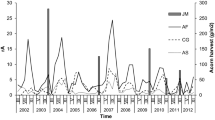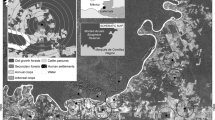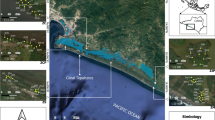Abstract
Whilst studies have shown that climatic (North Atlantic Oscillation (NAO)) and biotic (acorn production) factors influence rodent populations, mechanisms driving temporal and spatial fluctuation of rodent populations are understudied. This study evaluates relationships between the influence of environmental factors (biotic and abiotic) and phenotypic characteristics across two rodent feeding guilds (granivorous and non-granivorous species) represented by four species of rodents in Central Europe. We hypothesise that the relationship between acorn density and population growth rate are indirectly affected by climatic factors (winter NAO) and that these effects differ amongst herbivorous and granivorous species. In addition, we also tested whether effects of weather and competition on individual phenotype characteristic vary amongst mast and non-mast years. Rodent populations were estimated by catching individuals in snap traps during the growing season (from March to November) over a period of 9 years at three sites. The results of the generalised linear model provide evidence that acorn production best explained the population fluctuations. We therefore conclude that the between-year population fluctuations in rodent abundance were governed by density dependence and initiated primarily by acorn mast years. Auto-regressive models also revealed direct density dependence in combination with the direct effects of mast years. Therefore, strong intraspecific competition for food is likely in years following mast years. Our results also showed that abundance of non-granivorous species is mainly influenced by local weather conditions which could regulate food quality and abundance. On the other hand, population dynamics of granivorous species are caused directly by acorn density and indirectly by climatic condition influencing acorn production.








Similar content being viewed by others
References
Aanes R, Saether BE, Smith FM, Cooper EJ, Wookey PA, Øritslans NA (2002) The Arctic Oscillation predicts effects of climate change in two trophic levels in a high-arctic ecosystem. Ecol Lett 5:445–453
Aars J, Ims RA (2002) Intrinsic and climatic determinants of population demography: the winter dynamic of tundra voles. Ecology 83:3449–3456
Andrzejewski R, Olszewski J (1963) Social behaviour and interspecific relations in Apodemus flavicollis (Melchior, 1834) and Clethrionomys glareolus (Schreber, 1780). Acta Theriol 7:165–168
Brooks RT, Smith HR, Healy WM (1998) Small-mammal abundance at three elevations on a mountain in a central Vermont, USA: a sixteen-year record. For Ecol Manag 110:181–193
Čepelka L, Heroldová M, Jánová E, Suchomel J (2014) The dynamics of nitrogenous substances in rodent diet in a forest environment. Mammalia 78:327–333
Clotfelter ED, Pedersen AB, Cranford JA, Ram N, Snajdr EA, Nolan V, Ketterson ED (2007) Acorn mast drivers long-term dynamics of rodent and songbird populations. Oecologia 154:493–503
Dalgleish HJ, Swihart R (2012) American chestnut past and future: implications of restoration for resource pulses and consumer populations of eastern US forests. Restor Ecol 20:490–497
Elias SP, Witham JW, Hunter ML (2004) Peromyscus leucopus Abundance and acorn mast: population fluctuation patterns over 20 years. J Mammal 85:743–747
Elias SP, Witham JW, Hunter ML (2006) A cyclic red-backed vole (Clethrionomys gapperi) population and seedfall over 22 years in Maine. J Mammal 87:440–445
Fraschina J, Leon VA, Busch M (2012) Long-term variations in rodent abundance in a rural landscape of the Pampas, Argentina. Ecol Res 27:191–202
Grüm L, Bujalska G (2000) Bank voles and yellow-necked mice: what are interrelations between them? Pol J Ecol 48:141–145
Hansen TF, Stenseth NC, Henttonen H (1999) Multiannual vole cycles and population regulation during long winters: an analysis seasonal density dependence. Am Nat 154:129–139
Hansson L (1998) Mast seeding and population dynamics of rodents: one factor is not enough. Oikos 82:591–594
Htwe NM, Singleton GR (2014) Is quantity or quality of food influencing the reproduction of rice-field rats in the Philippines? Wildl Res 41:56–63
Hurrell J (1995) Decadal trends in the North Atlantic Oscillation: regional temperatures and precipitation. Science 269:676–679
Imholt C, Esther A, Perner J, Jacob J (2011) Identification of weather parameters related to regional population outbreak risk of common voles (Microtus arvalis) in eastern Germany. Wildl Res 38:551–559
Jȩdrzejewski W, Jȩdrzejewska B (1993) Predation on rodents in Bialowieza primeval forest, Poland. Ecography 16:47–64
Jiang GS, Liu J, Xu L, Yu GR, He HL, Zhang ZB (2013) Climate warming increases biodiversity of small rodents by favoring rare or less abundant species in a grassland ecosystem. Integr Zool 8:162–174
Kareiva P, Mulen A, Southwood R (1990) Population dynamics in spatially complex environments: theory and data. Philos Trans R Soc Lond B 330:175–190
Karels TJ, Boonstra R (2000) Concurrent density dependence and independence in populations of arctic ground squirrels. Nature 408:460–463
Kelly D, Koenig WD, Liebhold AM (2008) An intercontinental comparison of the dynamic behavior of mast seeding communities. Popul Ecol 50:329–342
Korpela K, Delgado M, Henttonen H, Korpimaki E, Koskela E, Ovaskainen O, Pietiainen H, Sundell J, Yoccoz NG, Huitu O (2013) Nonlinear effects of climate on boreal rodent dynamics: mild winters do not negate high-amplitude cycles. Glob Chang Biol 19:697–710
Korslund L, Steen H (2006) Small rodent winter survival: snow conditions limit access to food resources. J Anim Ecol 75:156–166
Koskela E, Jonsson P, Hartikanen T, Mappes T (1998) Limitation of reproductive success by availability and litter size in the bank vole, Clethrionomys glareolus. Proc R Soc Lond [Biol] 265:1129–1134
Lima M, Keymer JE, Jaksic FM (1999) El Niño–Southern Oscillation-driven rainfall variability and delayed density dependence cause rodent outbreaks in western South America: linking demography and population dynamics. Am Nat 135:476–491
Marcello GJ, Wilder SM, Meikle DB (2008) Population dynamics of a generalist rodent in relation to variability in pulsed food resources in a fragmented landscape. J Anim Ecol 77:41–46
McCafferty DJ, Moncrieff JB, Taylor IR (2003) Winter microclimate of field voles (Microtus agrestis) in SW Scotland. J Therm Biol 28:397–401
Perea R, Miguel AS, Jauregui MM, Carabaña MV, Gil L (2012) Effect of seed quality and seed location on the removal of acorns and beechnuts. Eur J For Res 131:623–631
Pucek Z, Jedrzejewski W, Jedrzejewska B, Pucek M (1993) Rodent population-dynamics in a primeval deciduous forest (Bialowieza National Park) in relation to weather, seed crop, and predation. Acta Theriol 38:199–232
R Development Core Team (2013) R: a language and environment for statistical computing. R Foundation for Statistical Computing, Vienna. Available at http://www.R-project.org
Randuška D, Vorel J, Plíva K (1986) Fytocenológia a lesnícka typológia [Phytocenology and forest typology]. Príroda, Bratislava
Saitoh T, Osawa J, Takanishi T, Hayakashi S, Ohmori M, Morita T, Uemura S, Vik JO, Stenseth NC, Maekawa K (2007) Effect of acorn masting on population dynamics of three forest-dwelling rodent species in Hokkaido Japan. Popul Ecol 49:249–256
Saitoh T, Vik JO, Stenseth NC, Takanishi T, Hayakashi S, Ishida N, Ohmori M, Morita T, Uemura S, Kadomatsu M, Osawa J, Maekawa K (2008) Effect of acorn abundance on density dependence in a Japanese wood mouse (Apodemus speciosus) population. Popul Ecol 50:159–167
Scarlett TL (2004) Acorn production and winter reproduction in white-footed mice (Peromyscus leucopus) in a southern piedmont forest. Southeast Nat 3:483–494
Schmidt K, Ostfeld R (2008) Numerical and behavioral effects within a pulse-driven system: consequences for shared prey. Ecology 89:635–646
Selås V, Framstad E, Spidsø TK (2002) Effect of seed masting of billberry, oak and spurce on sympatric populations of bank vole (Clethrionomys glareolus) and wood mouse (Apodemus sylvaticus) in southern Norway. J Zool 258:459–468
Shimada T, Saitoh T (2006) Re-evaluation of the relationship between rodent populations and acorn masting: a review from the aspect of nutrients and defensive chemicals in acorns. Popul Ecol 48:341–352
Stenseth NC, Viljugrein H, Jêdrzejewsky W, Mysterud A, Pucek Z (2002) Population dynamics of Clethrionomys glareolus and Apodemus flavicollis: seasonal components of density dependence and density independence. Acta Theriol 47:39–67
Suchomel J, Heroldová M (2008) Effect of seed crop of trees on the abundance and body parameters of granivorous mammals in isolated forest stands of southern Moravia (Czech Republic). Pol J Ecol 56:155–160
Suchomel J, Čepelka L, Purchart L (2012) Structure and diversity of small mammal communities of lowland forests in the rural central European landscape. Eur J For Res 131:1933–1941
Tkadlec E, Zejda J (1998a) Small rodent population fluctuations: the effects of age structure and seasonality. Evol Ecol 12:191–210
Tkadlec E, Zejda J (1998b) Density-dependent life histories in female bank voles from fluctuating populations. J Anim Ecol 67:863–873
Tkadlec E, Zboøil J, Losík J, Gregor P, Lisická L (2006) Winter climate and plant productivity predict abundances of small herbivores in central Europe. Clim Res 32:99–108
Tkadlec E, Suchomel J, Purchart I, Heroldová M, Čepelka I, Homolka M (2011) Synchronous population fluctuations of forest and field voles: implications for population management. JKI 432:97–98
Wang G, Wolff JO, Vessey SH, Slade NA, Wiham JW, Merritt JF, Hunter ML, Elias SP (2009) Comparative population dynamics of Peromyscus leucopus in North America: influences of climate, food, and density dependence. Popul Ecol 51:133–142
White TCR (2008) The role of food, weather and climate in limiting the abundance of animals. Biol Rev 83:227–248
Wolff JO (1996) Population fluctuations of mast-eating rodents are correlated with production of acorns. J Mammal 77:850–856
Xiao Z, Gao X, Zhang Z (2013) Sensitivity to seed germination schedule by scatter-hoarding Pére David’s rock squirrels during mast and non-mast years. Ethology 119:472–479
Zejda J (1966) Litter size in Clethrionomys glareolus Schreber 1780. Zool Listy 15:193–322
Zejda J (1967) Mortality of a population of Clethrionomys glareolus Schreb. In a bottomland forest in 1964. Zool Listy 16:221–238
Zejda J (1976) The small mammal community of a lowland forest. Acta Sc Nat Brno 10:1–39
Zejda J (2002) A yellow-necked mouse attacked a dead bank vole. Acta Theriol 47:221–222
Acknowledgements
This research was funded by the Grant Nos. 14-36098G from the GA CR and LO1415 from the MSMT. The work complies with Council Directive 86/609/EEC on the approximation of laws, regulations and administrative provisions of the Member States regarding the protection of animals used for experimental and other scientific purposes. We also thank Vera Pfeiffer who assisted with corrections related to the use of the English language.
Author information
Authors and Affiliations
Corresponding author
Additional information
Communicated by: Emerson M. Vieira
Electronic supplementary material
ESM 1
(DOCX 340 kb)
Rights and permissions
About this article
Cite this article
Šipoš, J., Suchomel, J., Purchart, L. et al. Main determinants of rodent population fluctuations in managed Central European temperate lowland forests. Mamm Res 62, 283–295 (2017). https://doi.org/10.1007/s13364-017-0316-2
Received:
Accepted:
Published:
Issue Date:
DOI: https://doi.org/10.1007/s13364-017-0316-2




